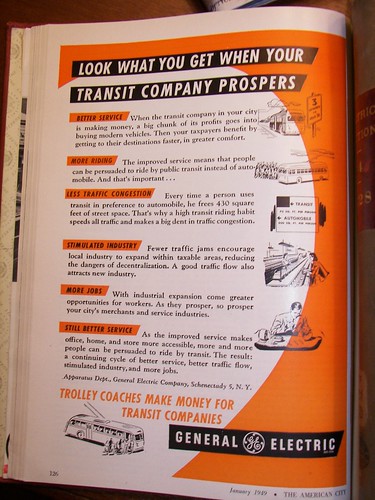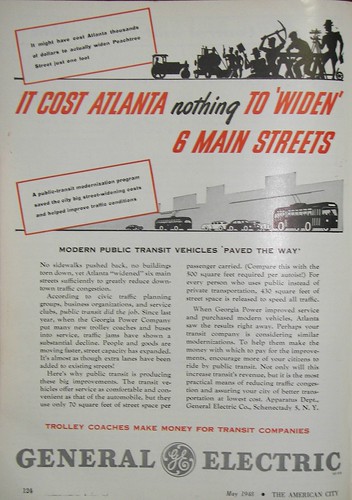The advantages of transit
 GE transit ad from January 1949. Published in American City, a trade magazine for city managers. The magazine is still published today, as American City and County.
GE transit ad from January 1949. Published in American City, a trade magazine for city managers. The magazine is still published today, as American City and County. GE transit ad from May 1948.
GE transit ad from May 1948.What happened, why did all the learning and understanding get junked? Below is something I wrote recently on an e-list in response to a piece about the PBS "History Detectives" show and how it has a program coming up about how GM, Standard Oil of New Jersey, and Firestone led a conspiracy to replace streetcars with buses. The fact is it's way more complicated and nuanced than that--just how history most often is, nuanced and more complicated than at first glance.
I'm all for beating up on GM, Firestone, and Exxon but they were merely icing on the cake. Long before their campaign to convert streetcar systems to bus systems (to sell buses, tires, and gasoline--GM didn't manufacture streetcars) streetcar systems were on the decline due to the availability of automobiles generally, and cheaper automobiles specifically (Henry Ford) which fueled outmigration and deconcentration in earnest beginning in the 1920s.
Before the Depression interurban systems were going out of business, and intracity streetcar systems too.
The Depression didn't help.
Nor did the Utility Holding Act, which eliminated cross-subsidy of streetcar systems by electricity generating companies. Many streetcar systems created electricity generating companies to run their systems, but the generating business became much bigger. When forced to make a choice between owning the electric company or the streetcar company, they chose the electric company...
And state and city regulation of streetcar systems and limits on fare increases underfunded the ability of such systems to invest in their infrastructure and remain competitive.
Not to mention the fact that they paid franchise fees and taxes, unlike the roads, which were used by vehicles that competed (gas taxes yes, but not property, this was a problem too for railroads compared to trucking companies).
WWII led to a resurgence of streetcar usage. No automobiles were produced during the war. Plus gas rationing--which was instituted not because of gas supplies, but because of lack of access to rubber for tires (the Japanese took control of Malaysia from the British). So people rode streetcars.
But after the war, due to the demand for consumption of consumer goods the price of streetcars went up greatly (demand for steel, etc.). Buses were seemingly cheaper to purchase (they had a shorter useful life, and reduced capacity compared to the average streetcar). So more streetcar lines were abandoned, even by systems not controlled by GM...
Plus, streetcar service was "too frequent" often every 3 minutes, leading to congestion.
Reducing frequency (headway) even by a couple minutes--from the need for 20 cars/hour to 15 or 12--would have reduced investment requirements.
Plus, the rush to the suburbs, fueled after 1954 by white flight, further deconcentrated the market for public transit and streetcars.I
t is incumbent on those of us demanding better public spaces to be accurate in the recounting of history. And if you're interested in finding out more, there was a good discussion of this topic earlier in the year on the H-URBAN e-list.
Index Keywords: transit; urban-design-placemaking



0 Comments:
Post a Comment
<< Home